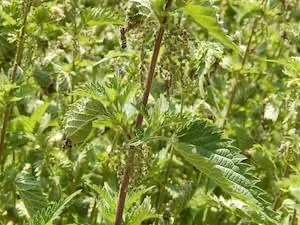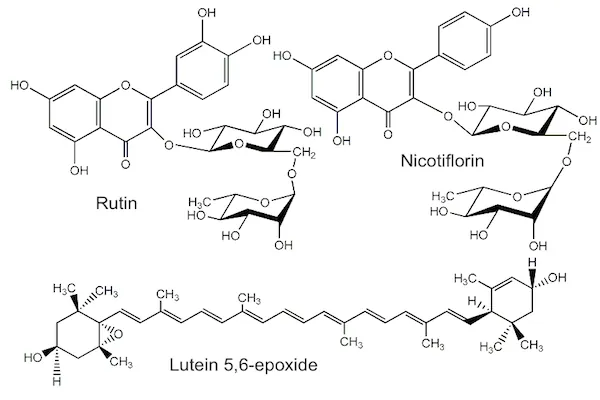Overview of Stinging Nettle
Scientific Name: Urtica dioica
Order: Rosales
Family: Urticaceae
Stinging nettle is called stinging nettle because of the "stinging hairs" (trichomes) on the leaves and stems that can cause a rash when touched. Do not eat stinging nettles raw. First stinging nettles are blanched to remove the stinging hairs, and then the water is drained. After rinsing and squeezing out any remaining water, the blanched stinging nettles are ready to be cooked and eaten like a vegetable. Do NOT confuse with Urtica ferox, a poisonous plant native to New Zealand.
Strong:
insufficient informationGood:
- Benign Prostate Hyperplasia (BPH)/Lower Urinary Tract Symptoms (LUTS), stinging nettle alone and in combination with avocado / soya oil; and pygeum appear to be effective [1-7]
- Nonetheless, stinging nettle with saw palmetto appear to be more effective, and in one case as effective as finasteride
Promising:
- Osteoarthritis/Joint Pain, stinging nettle alone and stinging nettle with fish oil / vitamin E [8-10]
- Type 2 Diabetes, including cardiovascular health in people with Type 2 Diabetes [11-13]
Conflicting (Unclear):
insufficient informationLimited Evidence:
- Allergic Rhinitis [14]
- Arthiritis, when stinging nettle was applied to the painful region of the skin [15]
- Burns, stinging nettle with arnica [16]
- Chronic Bacterial Prostatitis (CBP), stinging nettle with saw palmetto / quercetin / curcumin [17]
- Insect Bite (reduces erythema, but NOT itching), a homeopathic gel containing stinging nettle / Echinacea angustifolia / Ledum palustre / witch hazel extract [18]
- Stops Bleeding, stinging nettle with Thymus vulgaris / Glycyrrhiza glabra / Vitis vinifera / Alpinia officinarum [19-20]
No Evidence:
- Gingivitis [21]
No Clinical Research:
All other conditions.- Allergic Skin Reactions
- Decreased Urine Flow
- Diarrhea
- Itching
- Gastrointestinal Complaints
- Hives
- Rashes
- Stinging
- Sweating
- Swelling
- Avoid or contact a licensed healthcare practitioner, if you are sensitive to stinging nettle or are allergic to plants in the genus Urtica, or when there is fluid retention resulting from reduced heart or kidney functions.
- Handling stinging nettle can cause intense burning for 12 hours or even longer or urticaria, but washing the affected area thoroughly with soap and water may relieve the symptoms.
- An older man who regularly drank stinging nettle tea had edematous gingivostomatitis (swelling of the mouth and its mucous membranes), which may have been a serious allergic reaction.
- After taking a combination of stinging nettle/couch grass root/willow herb/onion bulb, a diabetic man became hypoglycemia.
- Strong diuretic effects have been reported in people with arthritis, and myocardial or chronic venous insufficiencies.
- A man began developing breast and a woman began over-producing milk after taking stinging nettle.
- Topically applied fresh nettle can cause rash, stinging, itching, and tongue swelling.
- A case of upper gastrointestinal bleeding occurred while using stinging nettle.
- Do NOT give stinging nettle to children under 2 years of age.
- Stinging nettle juice can sometimes cause diarrhea.
There is not enough research on the use of supplements containing stinging nettle during pregnancy and breast-feeding, so consult a licensed healthcare practitioner before use or avoid use. A case of an infant who sucked on nipples rubbed with stinging nettle developed rashes/hives (urticaria). Stinging nettle may stimulate the uterus. [22-28]
Major:
insufficient informationModerate:
insufficient informationPotential:
- Diuretics
- Iron
Stinging nettle is not a "drug", the best doses have not been thoroughly established. Make sure to follow the specific product instructions and take as directed on the label, or consult a licensed healthcare practitioner before use.
1. Bercovich E, Saccomanni M. Analysis of the results obtained with a new phytotherapeutic association for LUTS versus control. [corrected]. Urologia. 2010 Jul-Sep;77(3):180-6. Erratum in: Urologia. 2010 Oct-Dec;77(4):287. 2. Engelmann U, Walther C, Bondarenko B, Funk P, Schläfke S. Efficacy and safety of a combination of sabal and urtica extract in lower urinary tract symptoms. A randomized, double-blind study versus tamsulosin. Arzneimittelforschung. 2006;56(3):222-9. 3. Krzeski T, Kazón M, Borkowski A, Witeska A, Kuczera J. Combined extracts of Urtica dioica and Pygeum africanum in the treatment of benign prostatic hyperplasia: double-blind comparison of two doses. Clin Ther. 1993 Nov-Dec;15(6):1011-20. 4. Lopatkin N, Sivkov A, Walther C, Schläfke S, Medvedev A, Avdeichuk J, Golubev G, Melnik K, Elenberger N, Engelmann U. Long-term efficacy and safety of a combination of sabal and urtica extract for lower urinary tract symptoms--a placebo-controlled, double-blind, multicenter trial. World J Urol. 2005 Jun;23(2):139-46. 5. Lopatkin N, Sivkov A, Schläfke S, Funk P, Medvedev A, Engelmann U. Efficacy and safety of a combination of Sabal and Urtica extract in lower urinary tract symptoms--long-term follow-up of a placebo-controlled, double-blind, multicenter trial. Int Urol Nephrol. 2007;39(4):1137-46. 6. Safarinejad MR. Urtica dioica for treatment of benign prostatic hyperplasia: a prospective, randomized, double-blind, placebo-controlled, crossover study. J Herb Pharmacother. 2005;5(4):1-11. 7. Sökeland J. Combined sabal and urtica extract compared with finasteride in men with benign prostatic hyperplasia: analysis of prostate volume and therapeutic outcome. BJU Int. 2000 Sep;86(4):439-42. 8. Jacquet A, Girodet PO, Pariente A, Forest K, Mallet L, et al. Phytalgic, a food supplement, vs placebo in patients with osteoarthritis of the knee or hip: a randomised double-blind placebo-controlled clinical trial. Arthritis Res Ther. 2009;11(6):R192. 9. Randall C, Dickens A, White A, Sanders H, Fox M, et al. Nettle sting for chronic knee pain: a randomised controlled pilot study. Complement Ther Med. 2008 Apr;16(2):66-72. 10. Randall C, Meethan K, Randall H, Dobbs F. Nettle sting of Urtica dioica for joint pain--an exploratory study of this complementary therapy. Complement Ther Med. 1999 Sep;7(3):126-31. 11. Kianbakht S, Khalighi-Sigaroodi F, Dabaghian FH. Improved glycemic control in patients with advanced type 2 diabetes mellitus taking Urtica dioica leaf extract: a randomized double-blind placebo-controlled clinical trial. Clin Lab. 2013;59(9-10):1071-6. 12. Namazi N, Esfanjani AT, Heshmati J, Bahrami A. The effect of hydro alcoholic Nettle (Urtica dioica) extracts on insulin sensitivity and some inflammatory indicators in patients with type 2 diabetes: a randomized double-blind control trial. Pak J Biol Sci. 2011 Aug 1;14(15):775-9. 13. Namazi N, Tarighat A, Bahrami A. The effect of hydro alcoholic nettle (Urtica dioica) extract on oxidative stress in patients with type 2 diabetes: a randomized double-blind clinical trial. Pak J Biol Sci. 2012 Jan 15;15(2):98-102. 14. Mittman P. Randomized, double-blind study of freeze-dried Urtica dioica in the treatment of allergic rhinitis. Planta Med. 1990 Feb;56(1):44-7. 15. Randall C, Randall H, Dobbs F, Hutton C, Sanders H. Randomized controlled trial of nettle sting for treatment of base-of-thumb pain. J R Soc Med. 2000 Jun;93(6):305-9. 16. Huber R, Bross F, Schempp C, Gründemann C. Arnica and stinging nettle for treating burns - a self-experiment. Complement Ther Med. 2011 Oct;19(5):276-80. 17. Cai T, Mazzoli S, Bechi A, Addonisio P, Mondaini N, et al. Serenoa repens associated with Urtica dioica (ProstaMEV) and curcumin and quercitin (FlogMEV) extracts are able to improve the efficacy of prulifloxacin in bacterial prostatitis patients: results from a prospective randomised study. Int J Antimicrob Agents. 2009 Jun;33(6):549-53. 18. Hill N, Stam C, van Haselen RA. The efficacy of Prrrikweg gel in the treatment of insect bites: a double-blind, placebo-controlled clinical trial. Pharm World Sci. 1996 Jan;18(1):35-41. 19. Baykul T, Alanoglu EG, Kocer G. Use of Ankaferd Blood Stopper as a hemostatic agent: a clinical experience. J Contemp Dent Pract. 2010 Jan 1;11(1):E088-94. 20. Eyi EG, Engin-Ustün Y, Kaba M, Mollamahmutoğlu L. Ankaferd blood stopper in episiotomy repair. Clin Exp Obstet Gynecol. 2013;40(1):141-3. 21. van der Weijden GA, Timmer CJ, Timmerman MF, Reijerse E, Mantel MS, et al. The effect of herbal extracts in an experimental mouthrinse on established plaque and gingivitis. J Clin Periodontol. 1998 May;25(5):399-403. 22. Edgcumbe DP, McAuley D. Hypoglycaemia related to ingestion of a herbal remedy. Eur J Emerg Med. 2008 Aug;15(4):236-7. 23. Fetrow CW, Avila JR. The complete guide to herbal medicines. Spring House, PA, USA: Springhouse Corporation; 2000. 24. Gruenwald J, Brendler T, Jaenicke C, editors. PDR for herbal medicines. 4th ed. Montvale, NJ, USA: Thomson Healthcare; 2007. 25. Purnak T, Ozaslan E, Beyazit Y, Haznedaroglu IC. Upper gastrointestinal bleeding in a patient with defective hemostasis successfully treated with ankaferd blood stopper. Phytother Res. 2011 Feb;25(2):312-3. 26. Rodriguez-Fragoso L, Reyes-Esparza J, Burchiel SW, Herrera-Ruiz D, Torres E. Risks and benefits of commonly used herbal medicines in Mexico. Toxicol Appl Pharmacol. 2008 Feb 15;227(1):125-35. 27. Sahin M, Yilmaz H, Gursoy A, Demirel AN, Tutuncu NB, Guvener ND. Gynaecomastia in a man and hyperoestrogenism in a woman due to ingestion of nettle (Urtica dioica). N Z Med J. 2007 Nov 9;120(1265):U2803. 28. Uslu S, Bulbul A, Diler B, Bas EK, Nuhoglu A. Urticaria due to Urtica dioica in a neonate. Eur J Pediatr. 2011 Mar;170(3):401-3. 29. Fetrow CW, Avila JR. The complete guide to herbal medicines. Spring House, PA, USA: Springhouse Corporation; 2000. 30. Gruenwald J, Brendler T, Jaenicke C, editors. PDR for herbal medicines. 4th ed. Montvale, NJ, USA: Thomson Healthcare; 2007. 31. Afendi FM, Okada T, Yamazaki M, Hirai-Morita A, Nakamura Y, Nakamura K, Ikeda S, Takahashi H, Altaf-Ul-Amin M, Darusman LK, Saito K, Kanaya S. KNApSAcK family databases: integrated metabolite-plant species databases for multifaceted plant research. Plant Cell Physiol. 2012 Feb;53(2):e1.

